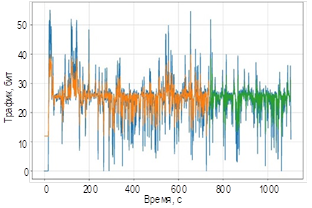
Traffic Prediction as a Multidimensional Random Process in a Three-Dimensional High-Density Internet of Things Network
https://doi.org/10.31854/1813-324X-2024-10-4-37-47
EDN: GCJROF
Abstract
Relevance. The relevance of the topic considered in the article lies in the active transformation of communication networks and the formation of a three-dimensional high-density communication network, which changes the structure of data traffic, therefore, for this type of network, a traffic model is considered as a multidimensional random process.
The main purpose of the study is to improve the efficiency of network traffic forecasting by developing a method, the distinctive feature of which is traffic forecasting as a multidimensional random process, taking into account the mutual dependence of individual flows produced by network nodes.
Methods. The paper considers an algorithm for training an artificial neural network (ANN) based on the method of reducing the root of the mean square error RMSE, and also proposes forecasting methods using LSTM-type ANNs and adapting model parameters to changing network operating conditions. The use of LSTM-type ANN for forecasting a multivariate random process describing traffic in a three-dimensional high-density network can yield better results than forecasting individual traffic flows as independent random processes due to the consideration of mutual influences between different traffic flows.
The results. Building the corresponding model, collecting statistics (obtaining a training sample), training the ANN and performing the forecast require the use of computing resources. Thus, the forecasting efficiency can be defined as a decrease in the forecasting error while maintaining the volume of resources used or a decrease in the volume of resources while maintaining the forecasting error. In the course of solving the scientific problem, criteria were identified for selecting the value of a unit interval (lag), which, together with the forecasting interval, significantly affects the final scenario.
The theoretical significance The scientific novelty of the work lies in the assessment of the change in the error in forecasting the traffic of a three-dimensional high-density communication network as a multivariate random process, compared to presenting the forecast of the same traffic as a set of independent random processes.
Significance (theoretical). The efficiency of traffic forecasting as a multidimensional random process in a three-dimensional high-density communication network increases with increasing dimensionality. Thus, such traffic in forecasting problems should be considered as a multidimensional random process, the dimensionality of which is equal to the number of network nodes producing traffic.
Significance (practical). The results obtained in the work can be used in the future to optimize the functioning of the traffic management system.
About the Authors
V. S. ElaginRussian Federation
A. А. Grebenshchikova
Russian Federation
References
1. Koucheryavy A., Paramonov A., Makolkina A., Muthanna A. S. A., Vybornova A., Dunaytsev R. , et. al. 3 Dimension Multilayer Heterogenous Ultra Dense Networks. Telecom IT. 2022;10(3):1–12. (in Russ.) DOI:10.31854/2307-1303-2022-10-3-1-12. EDN:LHLYEM
2. Bushelenkov S.N., Paramonov A.I. Analysis and formation of the structure of the internet of things network based on lattice models. Telecommunications. 2021;7:23−28. (in Russ.) DOI:10.34832/ELSV.2021.20.7.002. EDN:JIBLHT
3. Volkov A., Abdellah A.R., Muthanna A., Makolkina M., Paramonov A., Koucheryavy A. IoT traffic prediction with neural networks learning based on SDN infrastructure. Proceedings of 23rd International Conference on Distributed and Computer and Communication Networks, DCCN 2020, 14−18 September 2020, Moscow, Russia. Lecture Notes in Computer Science, vol.12563. IEEE; 2020. p.64−76. DOI:10.1007/978-3-030-66471-8_6. EDN:QRQIPV
4. Abdellah A.R., Mahmud O.A., Paramonov A.I., Koucheryavy A. Delay prediction in IoT and tactile internet using machine learning approach. Telecommunications. 2021;1:23−27. (in Russ.) DOI:10.34832/ELSV.2021.14.1.002. EDN:IRYPFV
5. Wentzell A.D. A Course in the Theory of Stochastic Processes. Moscow: Nauka Publ.; 1996. 399 p. (in Russ.)
6. Joshi M., Hadi T.H. A Review of Network Traffic Analysis and Prediction Techniques. 2015. URL: https://arxiv.org/abs/1507.05722 [Accessed 25.08.24]
7. Ferreira G.O., Ravazzi C., Dabbene F., Calafiore G.C., Fiore M. Forecasting Network Traffic: A Survey and Tutorial With Open-Source Comparative Evaluation. EEE Access. 2023;11:6018−6044. DOI:10.1109/ACCESS.2023.3236261
8. Vikulov A.S., Paramonov A.I. Problem statement of tiling the plane for frequency and area planning of IEEE 802.11 networks. Radio Engineering and Telecommunication Systems. 2021;1(41):24−32. (in Russ.) EDN:HNRRQO
9. Miller B.M., Pankov A.S. Theory of Random Processes in Examples and Problems. Мoscow: Fizmatlit Publ.; 2007. 320 c. (in Russ.)
10. Manzoor S., Bajwa K.B., Sajid M., Manzoor H., Manzoor M., Ali N., et. al. Modeling of Wireless Traffic Load in Next Generation Wireless Networks. Mathematical Problems in Engineering. 2021;1:15. DOI:10.1155/2021/7293093
11. Wang J., Tang J., Xu Z., Wang Y., Xue G., Zhang X., et. al. Spatiotemporal modeling and prediction in cellular networks: A big data enabled deep learning approach. Proceeding of IEEE Conference on Computer Communications, 01−04 May 2017, Atlanta, USA. IEEE; 2017. p.1−9. DOI:10.1109/INFOCOM.2017.8057090
12. Luo X., Li D., Yang Y., Zhang S. Spatiotemporal traffic flow prediction with KNN and LSTM. Journal of Advanced Transportation. 2019:1−10. DOI:10.1155/2019/4145353
13. Hochreiter S., Schmidhuber J. Long short-term memory. Neural computation. 1997;9(8):1735–80. DOI:10.1162/neco.1997.9.8.1735
14. Kavitha A.K., Praveena S.M. Deep learning model for traffic flow prediction in wireless network. Automatika. 2023;64(4):848−857. DOI:10.1080/00051144.2023.2220203
15. Sheluhin O.I., Smolskiy S.M., Osin A. V. Self‐Similar Processes in Telecommunications. Мoscow: Fizmatlit Publ; 2008. 368 p. (in Russ.) EDN:MVSWAB
16. Tsybakov B.S. Teletraffic model based on self-similar random process. Radiotechnica. 1999;5:24–31. (in Russ.)
17. Sheluhin O.I., Tenjakshev A.M., Osin A.V. Fractal Processes in Telecommunications. Moscow: Radiotehnika Publ.; 2003. 480 p. (in Russ.) EDN:UKUJXH
18. Sjöberg J., Ljung L. Overtraining, Regularization, and Searching for Minimum in Neural Networks. 1992. URL: https://www.researchgate.net/profile/J-Sjoberg/publication/2738519_Overtraining_Regularization_And_Searching_For_Minimum_With_Application_To_Neural_Networks/links/02e7e519f37e9a2f6e000000/Overtraining-Regularization-And-Searching-For-Minimum-With-Application-To-Neural-Networks.pdf [Accessed 26.08.2024]
Review
For citations:
Elagin V.S., Grebenshchikova A.А. Traffic Prediction as a Multidimensional Random Process in a Three-Dimensional High-Density Internet of Things Network. Proceedings of Telecommunication Universities. 2024;10(4):38-47. (In Russ.) https://doi.org/10.31854/1813-324X-2024-10-4-37-47. EDN: GCJROF


































